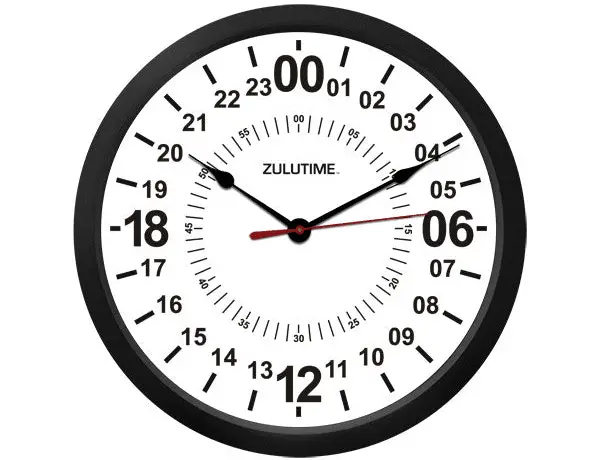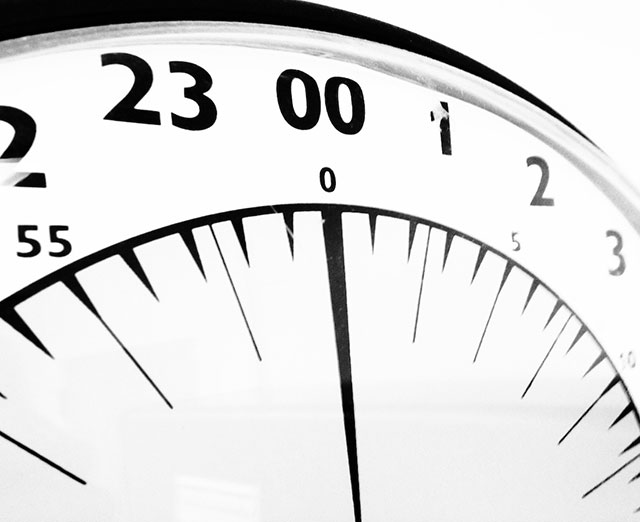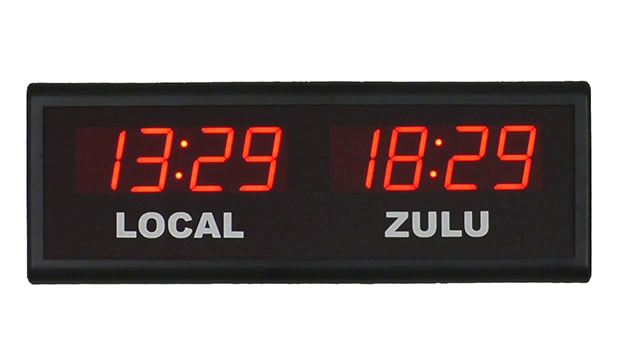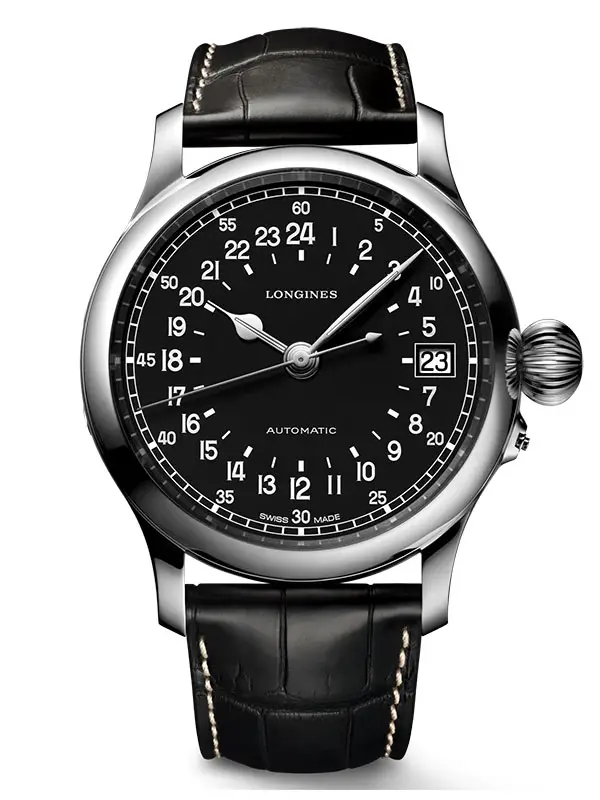CALCULATING MILITARY TIME
 Military time, also known as 24-hour time, measures time by dividing the day into the total 24 hours instead of the two blocks of 12 hours traditionally used by
standard time. In military time, the day begins at 0000 hours and ends at 2359 hours. Military and civilian organizations around the world such as emergency
services, public safety, transportation and logistics use this system.
Military time, also known as 24-hour time, measures time by dividing the day into the total 24 hours instead of the two blocks of 12 hours traditionally used by
standard time. In military time, the day begins at 0000 hours and ends at 2359 hours. Military and civilian organizations around the world such as emergency
services, public safety, transportation and logistics use this system.
Click here to try our free online Military Time Calculator.
The main advantage of using military time is its increased precision and accuracy. Using a 24-hour clock means no confusion between the morning and
afternoon hours caused by the AM/PM designations in standard time. This is particularly important in fields such as military operations, emergency services and
transportation, where every minute counts. Additionally, military time promotes consistency and standardization across different time zones and locations.
Understanding military time
Standard time, also known as 12-hour time, is the system of measuring the time used in most parts of the world. In this system, each day is divided into
two 12-hour periods: AM (ante meridiem, or before noon) and PM (post meridiem, or after noon). The hours are numbered from 1 to 12, and AM or PM is used to
distinguish between morning and afternoon/evening. For example, 12:00 AM is the start of the day, 12:00 PM is the middle of the day and 11:59 PM is the end of
the day.
In contrast, military time uses a 24-hour clock in which each day only has one 24-hour period. The hours are numbered from 00 to 23, with no AM or PM
designations. Using the same example for this system, 0000 is the start of the day, 1200 is the middle of the day and 2359 is the end of the day.
In both systems, minutes and seconds are added as follows:
- The minutes of each hour between 00 and 59 are added after the hour, with a colon separator for standard time and no separator for military time. For
example, 6:30 PM standard time is 1830 in military time.
- If seconds are being measured, the seconds of each minute between 00 and 59 are added after the minute, with both systems using a colon separator. For
example, 6:30:25 PM standard time is 1830:25 in military time.
Calculating military time
Let's look at calculating military time and converting between time systems.
Converting from standard time to military time
If you want to convert a time from standard time to military time, simply follow these steps:
- Remember that midnight is usually represented as 0000 (not 2400) and noon is represented as 1200 in military time.
- If the hour is 9 AM or less, put a leading zero before it. In military time, all hours must have two digits.
- If the hour is 1 PM or more, add 12 to it.
- Minutes and seconds (if any) remain the same.
- Remove the colon between the hour and minutes.
- Remove the AM/PM designation.
For example, 3:00 AM standard time converts to 0300 in military time. Alternatively, 3:00 PM converts to 1500.
Converting from military time to standard time
Converting from military time to standard time is just as easy. Simply follow these steps:
- If the hour is 09 or less, remove the leading zero.
- If the hour is 13 or more, subtract 12 from it.
- Minutes and seconds (if any) remain the same.
- Insert a colon between the hour and minutes.
- Add the relevant AM/PM designation.
For example, 0900 military time converts to 9:00 AM in standard time. Alternatively, 2100 converts to 9:00 PM.
Examples
Here are some more examples of military time conversions to illustrate the concepts:
- 12:00 AM (standard time) is 0000 in military time.
- 1:15 AM (standard time) is 0115 in military time.
- 3:30 PM (standard time) is 1530 in military time.
- 10:45 PM (standard time) is 2245 in military time.
- 11:21:18 PM (standard time) is 2321:18 in military time.
If you want to see the current time in military time, click here to use our Military Time Calculator.
Speaking Military Time
When speaking military times, the leading zero is spoken for the hours between 0000 and 0959. There are a few other tricks, so we'll list some more examples
to show pronunciation:
- Midnight is 0000 and pronounced "zero-hundred", not "zero-zero-zero-zero".
- 12:15 AM is 0015 and pronounced "Zero-hundred-fifteen".
- 4:00 AM is 0400 and pronounced "zero-four-hundred".
- 9:59 AM is 0959 and pronounced "zero-nine-fifty-nine".
- 10:00 AM is 1000 and pronounced "ten hundred", not "one thousand".
- 11:45 PM is 2345 and pronounced "twenty-three-forty-five".
In casual speech, particularly in the movies, "oh" is sometimes used instead of "zero" (such as "oh-four-hundred"), however "zero" is the correct military
protocol.
Is military time the same as 24-hour time
Many people use the terms military time and 24-hour time interchangeably, and their usage is almost identical, however there are two main differences. Firstly,
military time uses a leading zero without a colon, whereas 24-hour time uses a colon without a leading zero. For example, 9:00 AM is referred to as 0900 in
military time and 9:00 in 24-hour time, while 9:00 PM is 2100 and 21:00, respectively.
 Sometimes, midnight causes confusion. In the 24-hour time system, the day starts at midnight, referred to as 00:00 or 0:00, and ends at the last minute of
the day, referred to as 23:59. However, 24:00 can also be used to refer to midnight at the end of a specified date. In other words, 24:00 today is the same
time as 00:00 tomorrow. It's mainly used when a specified period ends at midnight, such as arrival times, business closing times, or the expiry
of legal agreements. For comparison, the United States military currently stipulates that a day runs from 0000 to 2359 in military time.
Sometimes, midnight causes confusion. In the 24-hour time system, the day starts at midnight, referred to as 00:00 or 0:00, and ends at the last minute of
the day, referred to as 23:59. However, 24:00 can also be used to refer to midnight at the end of a specified date. In other words, 24:00 today is the same
time as 00:00 tomorrow. It's mainly used when a specified period ends at midnight, such as arrival times, business closing times, or the expiry
of legal agreements. For comparison, the United States military currently stipulates that a day runs from 0000 to 2359 in military time.
Examples of Military Time Usage
Military time is widely used by the military and other organizations worldwide, particularly in fields where precision and accuracy are essential.
Some examples of military time usage include:
- Military operations: Military time is used to coordinate operations, maintain discipline and order, and ensure the safety of military personnel.
- Emergency services: Emergency services such as fire and rescue, police and paramedics use military time to keep track of incidents, respond to emergencies
and coordinate efforts.
- Transportation and logistics: Military time is used in transportation and logistics to ensure efficient scheduling of flights, trains and trucking.
- Civilian uses: In specific civilian settings, military time is used to ensure consistency and accuracy in scheduling and timekeeping, for example, in some
hospital and factory settings, as well as in some military-related industries.
What does Zulu mean?
 When used with military time, "Zulu" or "Z" means Coordinated Universal Time (UTC), which is the primary time standard by which the world regulates clocks
and time. UTC is the successor to Greenwich Mean Time (GMT) and is used as the standard time for military and other organizations coordinating
activities across different time zones. For example, as well as the military, it's often used in areas such as aviation and weather forecasting.
When used with military time, "Zulu" or "Z" means Coordinated Universal Time (UTC), which is the primary time standard by which the world regulates clocks
and time. UTC is the successor to Greenwich Mean Time (GMT) and is used as the standard time for military and other organizations coordinating
activities across different time zones. For example, as well as the military, it's often used in areas such as aviation and weather forecasting.
When military personnel use the term "Zulu" to indicate a time, they are referring to UTC. For example, suppose a military operation is scheduled to begin at
0900Z (pronounced "zero nine hundred Zulu"). In that case, it means that it will begin at 0900 UTC, which is equivalent to 5:00 AM Eastern Standard Time (EST)
in the United States. Using the term "Zulu" in this context helps to avoid confusion caused by different time zones.
History of military time
The use of military time can be traced back to ancient civilizations and has evolved over time to become the widely used system it is today. Let's take a
closer look at the history of military time, including its origins, development and international adoption.
Origins of Military Time
The concept of dividing the day into 24 equal parts can be traced back to ancient civilizations, such as the Egyptians and Babylonians. This system, in which
each hour was determined by the sun's position in the sky, was inherently imprecise and limited by the Earth's rotation and the sun's movement.
In the centuries that followed, various cultures and civilizations developed their own time measurement systems, including sundials, water clocks and
hourglasses. However, it wasn't until the invention of mechanical clocks in the 14th century that timekeeping became more accurate and widely available.
Development of Military Time
Although several ancient civilizations used a 24-hour time system, it wasn't until the 19th century that the modern system of military time began to take
shape.
One of the critical factors in the development of military time was the rapid advancements in technology and transportation during the 19th century. With the
advent of railroads and telegraphs, it became increasingly necessary to have a standardized time system that could be used across different time zones and
locations.
In 1855, the Royal Observatory in Greenwich, England, introduced Greenwich Mean Time (GMT) as a standard time reference, which the International Meridian
Conference later adopted in 1884. This established the Prime Meridian at Greenwich as the reference for determining longitude and time, and set the
stage for the widespread adoption of military time.
International Adoption of Military Time
Military time was first widely adopted by the military and other government organizations during the late 19th and early 20th centuries. The use of military
time was found to be essential for coordinating operations, maintaining discipline and order, and ensuring the safety of military personnel.
During World War II, military time became even more critical for coordinating military operations and logistical support. Following the war,
military time was adopted more broadly by civilian organizations such as airlines, where precise timekeeping is vital.
Today, military time is widely used by organizations worldwide and is an essential tool for keeping operations running smoothly and efficiently. Its
use is also standard practice in several countries, such as France and Germany. However, it's important to note that military time isn't universally
accepted and still not mandatory for countries to use it. Some countries, such as the US, use both military and standard time, while others, such as the United
Kingdom, primarily use standard time.
Uses of military time
Let's take a closer look at the various applications of military time, including its use in military and government operations, emergency services,
transportation and logistics, and civilian settings.
 Military and Government Operations
Military and Government Operations
The military and other government organizations widely use military time to coordinate operations, maintain discipline and order, and ensure the
safety of military personnel. The use of military time is critical for ensuring that operations run smoothly and efficiently, and it's an essential tool for
keeping track of troop movements, scheduling training exercises and monitoring equipment maintenance.
The use of military time is also essential for communication between different branches of the military and between various military organizations in
different countries. Using a common time system promotes consistency and standardization, which is vital for compatibility and systems integration in
joint operations.
Emergency Services
Emergency services such as fire and rescue, police and paramedics use military time to keep track of incidents, respond to emergencies and coordinate efforts.
It plays a vital role in enabling emergency services to swiftly and efficiently respond to incidents and monitor the progress of emergency operations.
In addition, using military time is essential for communication between different emergency services organizations and jurisdictions. This helps to ensure
effective coordination of efforts and successful emergency responses.
Transportation and Logistics
In transportation and logistics, military time is used extensively to improve the efficiency of flight, train and trucking timetables. It's a critical element
of maintaining a smooth and efficient logistics operation and monitoring the timing of transportation schedules.
Once again, using military time also facilitates communication between various transportation and logistics organizations in different regions,
contributing to the effective coordination of efforts and the success of their transportation operations.
Civilian Uses
Military time is also used in many civilian settings to ensure consistency and accuracy in scheduling and timekeeping. Examples include hospitals and
factories as well as military-related industries. However, civilian use of military time is sometimes limited by the confusion it can cause if people struggle
to understand and convert military times.
Advantages of using military time
The use of military time offers many advantages, including precision and accuracy, avoidance of confusion, consistency and standardization.
Increased Precision and Accuracy
One of the main advantages of using military time is its increased precision and accuracy. As we've seen, this is particularly important in fields such as
military operations, emergency services and transportation, where every minute counts. Additionally, military time promotes consistency and
standardization across different time zones and locations.
Avoidance of Confusion
Another advantage of using military time is avoiding confusion caused by the AM/PM designation in standard time. For example, in standard time, it can
be difficult to tell whether a time of 8:00 o'clock refers to the morning or evening, as it could be either 8:00 AM or 8:00 PM. With military time, using
a 24-hour clock eliminates this confusion, making it clear what time of day it's referring to.
Consistency and Standardization
Using military time promotes consistency and standardization across different time zones and locations. This is particularly important in fields such as
transportation and logistics where coordinating and standardizing operations is critical. Additionally, military time allows for clear communication
between different organizations, regardless of location, which is essential for ensuring efficient and effective operations.
Other Advantages
There are many other advantages of using military time. In particular, it's easy to learn and understand, simple to read and convert times, and
once mastered it becomes intuitive. Additionally, using military time makes it easy to compare time across different time zones, which is essential for
coordinating and planning international operations. Furthermore, military time is less prone to human error when compared with the traditional standard time
system since it doesn't require the additional step of deciding whether a time falls in the morning or the evening.
Challenges and criticisms of military time
While military time is widely used by organizations worldwide, particularly in fields where precision and accuracy are essential, it has challenges and
criticisms. Let's examine these issues in more detail.
Ease of Use
One of the main challenges of using military time in civilian settings is that many people may be unfamiliar with this time system. As a result, even though
it's easy to learn, those people often find it challenging to understand and convert between standard and military time. This has the potential to confuse and
becomes a barrier to its adoption and use.
Public Acceptance
Another challenge of using military time is that the general public may not accept it. Many people are used to standard time and may find it
difficult to switch to military time. Additionally, people may prefer the traditional system of displaying the hours using the 12-hour clock with AM/PM
designations. This resistance to change can make it difficult for non-military organizations to implement military time.
Other Challenges
Reading military time can present another challenge for people who aren't used to it. Using a block of four digits to represent times can be more complicated
to read than the standard time system. Furthermore, the absence of worldwide standardization and the lack of clear guidelines for its use can lead to
further confusion and errors when communicating time across different cultures or countries.
Criticisms
Military time has been criticized as being too rigid, and some argue that using a 24-hour clock is unnecessary in a non-military environment.
Additionally, they complain that it can be confusing for people unfamiliar with it and suggest that the standard time system is sufficient for most
everyday uses.
Conclusion
In conclusion, military time is widely used by military and other organizations worldwide. Overall, it's a time measurement system that's
characterized by increased accuracy, consistency and standardization and helps to avoid the confusion inherent in standard time. As a result, understanding
military time and time conversions are important skills for anyone working in a military, aviation or emergency services profession, as well as anyone who
wants to improve their time management and communication skills.


 Military time, also known as 24-hour time, measures time by dividing the day into the total 24 hours instead of the two blocks of 12 hours traditionally used by
standard time. In military time, the day begins at 0000 hours and ends at 2359 hours. Military and civilian organizations around the world such as emergency
services, public safety, transportation and logistics use this system.
Military time, also known as 24-hour time, measures time by dividing the day into the total 24 hours instead of the two blocks of 12 hours traditionally used by
standard time. In military time, the day begins at 0000 hours and ends at 2359 hours. Military and civilian organizations around the world such as emergency
services, public safety, transportation and logistics use this system. Sometimes, midnight causes confusion. In the 24-hour time system, the day starts at midnight, referred to as 00:00 or 0:00, and ends at the last minute of
the day, referred to as 23:59. However, 24:00 can also be used to refer to midnight at the end of a specified date. In other words, 24:00 today is the same
time as 00:00 tomorrow. It's mainly used when a specified period ends at midnight, such as arrival times, business closing times, or the expiry
of legal agreements. For comparison, the United States military currently stipulates that a day runs from 0000 to 2359 in military time.
Sometimes, midnight causes confusion. In the 24-hour time system, the day starts at midnight, referred to as 00:00 or 0:00, and ends at the last minute of
the day, referred to as 23:59. However, 24:00 can also be used to refer to midnight at the end of a specified date. In other words, 24:00 today is the same
time as 00:00 tomorrow. It's mainly used when a specified period ends at midnight, such as arrival times, business closing times, or the expiry
of legal agreements. For comparison, the United States military currently stipulates that a day runs from 0000 to 2359 in military time. When used with military time, "Zulu" or "Z" means Coordinated Universal Time (UTC), which is the primary time standard by which the world regulates clocks
and time. UTC is the successor to Greenwich Mean Time (GMT) and is used as the standard time for military and other organizations coordinating
activities across different time zones. For example, as well as the military, it's often used in areas such as aviation and weather forecasting.
When used with military time, "Zulu" or "Z" means Coordinated Universal Time (UTC), which is the primary time standard by which the world regulates clocks
and time. UTC is the successor to Greenwich Mean Time (GMT) and is used as the standard time for military and other organizations coordinating
activities across different time zones. For example, as well as the military, it's often used in areas such as aviation and weather forecasting. Military and Government Operations
Military and Government Operations